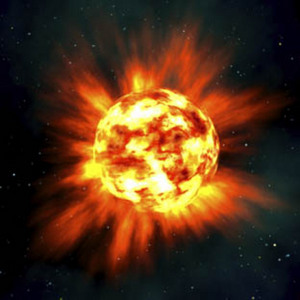Aug. 21, 2009 Research Highlight Physics / Astronomy
Netting new physics from a stellar collapse
Failed supernovae could provide a strong flux of neutrinos near the detection limit of current observatories
 Figure 1: An artist’s impression of a star going supernova. However some very large stars may collapse into black holes instead.
Figure 1: An artist’s impression of a star going supernova. However some very large stars may collapse into black holes instead.
Stars more than eight times the mass of our Sun eventually collapse under their own weight, and may explode into spectacular supernovae (Fig. 1). The temperatures and pressures generated in these events are so intense they create a large burst of particles called neutrinos, which eventually reach Earth.
Now, Cecilia Lunardini at Arizona State University and RIKEN BNL Research Center in Upton, USA, has calculated that lots of neutrinos may also reach Earth from ‘failed supernovae’—huge stars that collapse without exploding to produce black holes1.
The neutrino contribution from these failed supernovae could greatly increase the total flux of neutrinos reaching Earth from millions of collapsing stars throughout the universe. Lunardini calls this total the ‘diffuse supernova neutrino flux’.
“In the diffuse flux, the contribution of each supernova is very small, but the total is detectable,” she says. “We only need to reach the right experimental sensitivity to start detecting it.”
Unfortunately, neutrinos are notoriously difficult to detect because they barely interact with other matter. One of the world’s best detectors is the Super-Kamiokande (‘Super-K’) neutrino observatory, situated in a mine beneath Gifu prefecture Japan, and even it requires 50,000 tons of ultra-pure water to scatter the neutrinos.
Lunardini decided to calculate whether a device like Super-K could detect neutrinos from supernovae collapsing into black holes.
“The idea that neutrinos are emitted in black-hole-forming collapses is not new,” she says. “The novelty of my work is in showing that these neutrinos can build up to a significant diffuse flux, thus adding to the flux from successful supernovae.”
In fact, Lunardini calculated that the Earth may receive up to one neutrino per square centimeter per second from failed supernovae. This is even more than the flux from successful supernovae, but probably beyond the detection limit of Super-K.
There is growing support in the scientific community to build larger, more sensitive neutrino detectors containing up to a million tons of water. Once these bigger detectors are built, Lunardini thinks it is only a matter of time before the diffuse neutrino flux can be measured. The results could reveal some fascinating new physics.
“[Failed supernovae] are very difficult to study with telescopes due to the fact that they do not explode but just disappear from the sky without much emission other than neutrinos,” says Lunardini. “The possibility to get information on these objects—even just to test their presence and how many there are in the universe—with neutrinos is exciting.”
References
- 1. Lunardini, C. Diffuse neutrino flux from failed supernovae. Physical Review Letters 102, 231101 (2009). doi: 10.1103/PhysRevLett.102.231101
